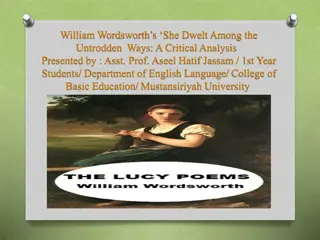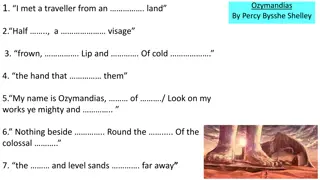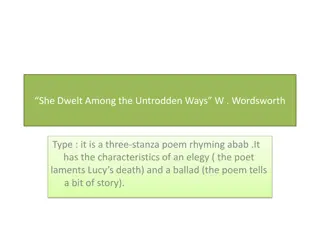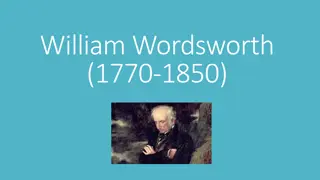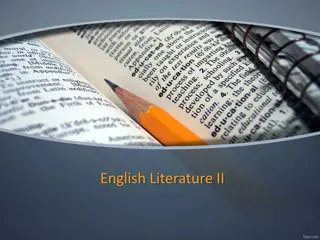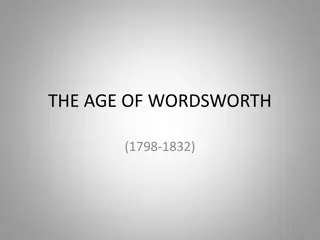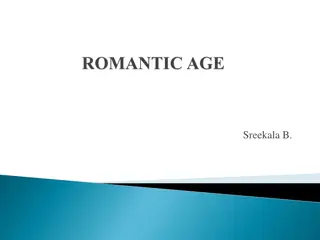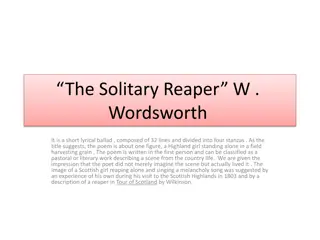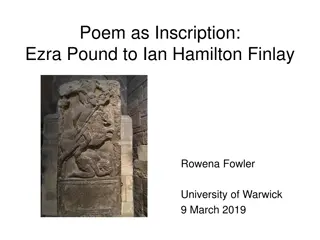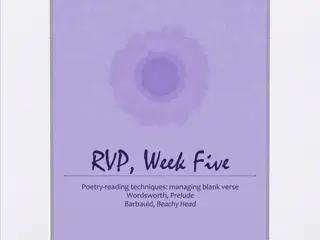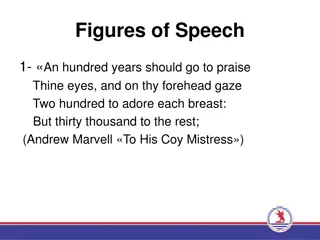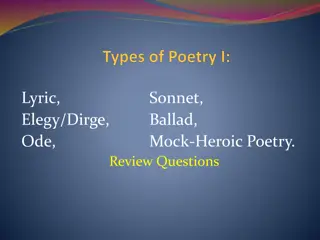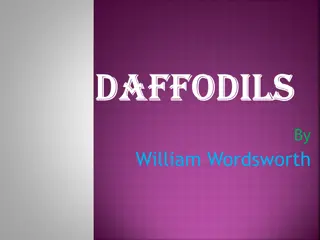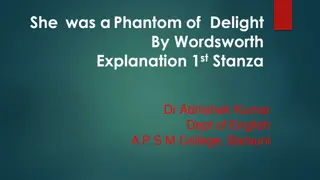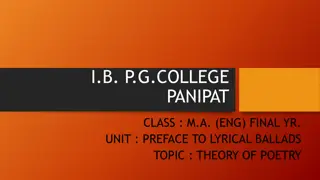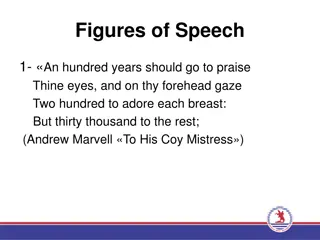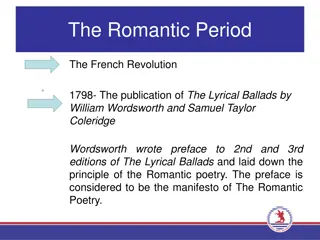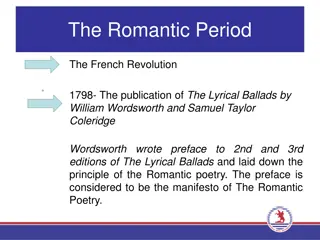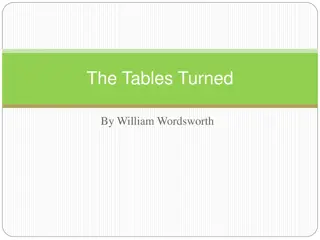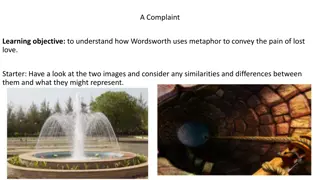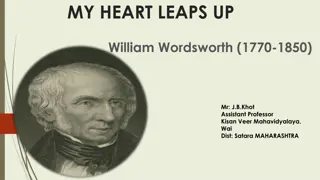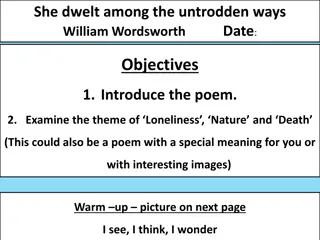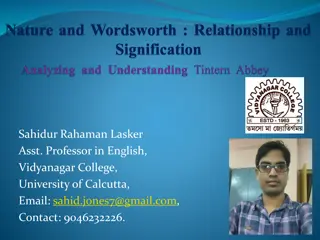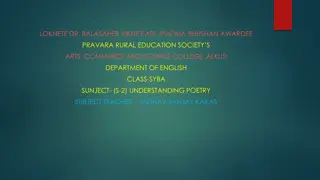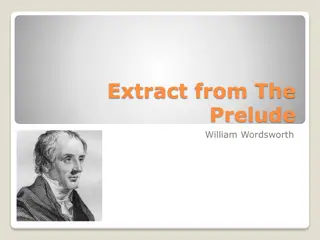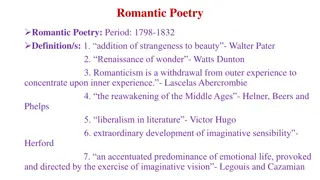Analysis of William Wordsworth's "She Dwelt Among the Untrodden Ways
William Wordsworth's poem "She Dwelt Among the Untrodden Ways" from the Lucy series explores themes of loneliness, beauty, and death through simple language and elegiac tone. The poem juxtaposes the beauty of nature with the mysterious and distant character of Lucy, symbolizing unrequited love and l
0 views • 8 slides
Selection of Poems by Shelley, Blake, Browning, Wordsworth, Tennyson, Owen, and Heaney
A diverse collection of poems by renowned poets such as Percy Bysshe Shelley, William Blake, Robert Browning, William Wordsworth, Alfred Lord Tennyson, Wilfred Owen, and Seamus Heaney. Each poem delves into different themes and emotions, showcasing the beauty and power of poetry through vivid imager
2 views • 15 slides
Analysis of "She Dwelt Among the Untrodden Ways" by Wordsworth
She Dwelt Among the Untrodden Ways" by Wordsworth is a three-stanza poem that combines elegy and ballad elements to lament the death of Lucy, a character portrayed as isolated and pure. The poem describes Lucy's solitude, uniqueness, and the poet's deep affection for her, ultimately portraying her a
0 views • 6 slides
William Wordsworth (1770-1850): Poet of Nature and Memory
William Wordsworth, a renowned English poet, was born in 1770 and his works were inspired by the landscapes of the Lake District. His collaboration with Coleridge in publishing "Lyrical Ballads" marked a significant moment in Romantic poetry. Wordsworth's emphasis on simplicity, nature, memory, and
0 views • 7 slides
The Romantic Period in English Literature: Embracing Emotion and Individualism
The Romantic period (1798-1837) in English literature was marked by a shift towards valuing emotion, individualism, and nature over rationalism and industrialization. Influenced by societal changes, the movement included prominent poets like William Wordsworth, Samuel Taylor Coleridge, and Robert Bu
0 views • 33 slides
The Romantic Age of Wordsworth: An Overview
The Romantic period in English literature, known as the Age of Wordsworth, emphasized emotions, individualism, nature's beauty, and common people's simplicity. William Wordsworth, a prominent English Romantic poet, co-authored Lyrical Ballads with Samuel Taylor Coleridge, and his notable work includ
2 views • 23 slides
The Impact of Political and Social Revolution in the Romantic Period (1785-1830)
England underwent significant changes during the Romantic Period (1785-1830) as it transitioned from an agricultural to an industrial nation, shifting economic power dynamics. This period was marked by wars, inflation, and social upheaval, leading to a revolution in literature and a focus on inner e
1 views • 14 slides
The Romantic Poet William Wordsworth: Life, Works, and Influence
William Wordsworth, a prominent Romantic poet, was known for his connection to nature, emphasis on individualism, and rejection of industrialization. This summary discusses his life, notable works like "Lyrical Ballads," and his impact on the Romantic Movement.
1 views • 18 slides
Analysis of "The Solitary Reaper" by Wordsworth
A lyrical ballad by Wordsworth, "The Solitary Reaper" captures the scene of a Highland girl singing and reaping in a field. The speaker, mesmerized by her melancholy song, speculates on its meaning, ultimately realizing that the beauty of her voice is what truly moves him. The poem evokes themes of
0 views • 5 slides
Inscriptions in Words: A Collection of Poetic and Historical Epitaphs
Explore a captivating compilation of inscriptions, ranging from poetic verses by renowned writers like John Donne and William Wordsworth to historical Roman epitaphs. Immerse yourself in the beauty of language and the depth of meaning conveyed through these inscriptions etched in time.
0 views • 19 slides
Exploring Poetry Reading Techniques and Themes in Blank Verse Literature
Dive into the world of poetry reading techniques and themes in blank verse literature through the exploration of Wordsworth's "Prelude," Barbauld's works, and "Beachy Head." Discover the nuances of managing blank verse, the shift from epic to romantic poetry, and the reflective and organizational as
4 views • 22 slides
Examples of Figures of Speech in Poetry
This collection showcases various examples of figures of speech used in poetry by renowned poets such as Andrew Marvell, Coleridge, Wordsworth, R.S. Thomas, and John Donne. The excerpts include metaphors, similes, personification, and other literary devices, offering a diverse range of creative expr
1 views • 10 slides
Dreams Explored: Poetic Perspectives of William Wordsworth, D.H. Lawrence, and Langston Hughes
Delve into the world of dreams through the lens of renowned poets William Wordsworth, D.H. Lawrence, and Langston Hughes. Discover the poetic interpretations and societal impacts of dreams as envisioned by these literary figures, exploring themes of aspiration, social change, and cultural movements
0 views • 26 slides
Understanding Different Forms of Poetry
Explore the characteristics of different types of poetry such as lyric, elegy/dirge, ode, sonnet, ballad, and mock-heroic poetry. Delve into the personal feelings expressed in lyric poems and the structured beauty of sonnets. Discover the emotive power of elegies and the celebratory nature of odes.
2 views • 15 slides
Coleridge's Cardinal Points of Poetry in Biographia Literaria
Coleridge's Chapter 14 in Biographia Literaria delves into the cardinal points of poetry, emphasizing the power to evoke reader sympathy through truth to nature and novelty through imaginative coloring. He discusses the difference between poetry and prose, highlighting the poet's role in crafting or
1 views • 37 slides
Analysis of Wordsworth's Poem 'Daffodils': Nature and Solitude
Explore the beauty of William Wordsworth's poem "Daffodils" which vividly describes a serene encounter with nature, specifically daffodils beside a lake. The poem reflects the poet's deep connection with nature and the joy it brings, emphasizing the bliss found in solitude and the lasting impact of
0 views • 17 slides
Analysis of "She was a Phantom of Delight" by Wordsworth
The poem "She was a Phantom of Delight" by William Wordsworth portrays a woman as a delightful and enchanting figure, described with vivid imagery. The poet's admiration for her beauty and spirit is evident in the first stanza, where he compares her to a lovely apparition with eyes like stars and du
0 views • 8 slides
Introduction to Poetry Analysis: Techniques and Approaches" (66 characters)
Delve into the world of poetry analysis with key insights on understanding the poet's craft, approaching unseen poems confidently, and identifying literary devices to unravel thematic content. Explore how to analyze poems effectively using the ART WARS framework and break free from common misconcept
0 views • 12 slides
Analysis of Wordsworth's Preface to Lyrical Ballads
William Wordsworth's Preface to Lyrical Ballads serves as a manifesto for the Romantic movement, emphasizing the use of common language and the expression of emotion in poetry. Wordsworth defines poetry as the spontaneous overflow of powerful feelings, rooted in contemplation rather than mere sponta
0 views • 10 slides
Exploring Various Definitions of Poetry
Delve into the multifaceted nature of poetry through different perspectives such as poetry as a lie according to Plato, poetry as truth per Aristotle, poetry as prophecy as observed by T.S. Eliot, poetry as an expression of emotion according to Wordsworth and Mills, and poetry as substance as articu
0 views • 13 slides
Exploring Figures of Speech in Poetry
Dive into the world of poetic expressions with a collection of famous figures of speech from renowned poets like Andrew Marvell, Coleridge, Wordsworth, and John Donne. Explore the rich imagery and metaphorical language used to convey deep emotions and vivid narratives in these classic literary works
0 views • 10 slides
The Romantics: Poetry and Revolution in the French Revolution Era
The Romantic Period was marked by the publication of "The Lyrical Ballads" by Wordsworth and Coleridge, setting the principles of Romantic poetry. Emphasizing emotions and nature, Romantic poets like Wordsworth, Shelley, Coleridge, and Keats used everyday life and rural language to express their fee
0 views • 6 slides
The Romantic Period: Influence of the French Revolution on Poetry
The French Revolution of 1798 had a profound impact on poetry during the Romantic Period, exemplified by the publication of "Lyrical Ballads" by William Wordsworth and Samuel Taylor Coleridge. Wordsworth's preface to the collection laid out the principles of Romantic poetry, emphasizing the expressi
0 views • 6 slides
Nature's Teaching: Analysis of "The Tables Turned" by William Wordsworth
The poem "The Tables Turned" by William Wordsworth encourages learning through nature and experience rather than books. It portrays a speaker urging students to embrace nature as their teacher, emphasizing the value of practical education over theoretical learning. The poem reflects Wordsworth's bel
0 views • 11 slides
Exploring Wordsworth's Use of Metaphor in "A Complaint" Poem
Dive into an analysis of Wordsworth's poem "A Complaint" to unravel how he utilizes metaphor to express the anguish of lost love. Discover the contextual background, poetic structure, and thematic elements woven throughout the Romantic piece. Explore the imagery of water, the emotional tone, and the
0 views • 9 slides
Analysis of "My Heart Leaps Up" by William Wordsworth
William Wordsworth's poem "My Heart Leaps Up," also known as "The Rainbow," reflects on the joy of witnessing a rainbow and how the poet's childhood continues to influence his perspectives into adulthood. The poem encapsulates the theme of the child shaping the adult and the enduring connection to n
0 views • 5 slides
Analysis of Loneliness, Nature, and Death in "She Dwelt Among the Untrodden Ways" by William Wordsworth
The poem "She Dwelt Among the Untrodden Ways" by William Wordsworth explores the themes of loneliness, nature, and death through the story of a woman named Lucy. The poet vividly describes Lucy's secluded existence, her beauty akin to a hidden violet, and the impact of her death on his own life. Thr
0 views • 24 slides
Exploring Nature in Poetry: Emerson and Wordsworth Perspectives
Delve into the profound connections between nature and poetry as interpreted by Emerson and Wordsworth. Emerson's transparent eyeball concept and Wordsworth's communion with nature reveal the deep spiritual and philosophical dimensions of the natural world in their works. Themes of unity, harmony, a
0 views • 10 slides
Romantic Poetry and Poets of the Romantic Era
Romantic poetry is characterized by emotional spontaneity, self-expression, and a deep connection to nature. Key poets of the Romantic era include William Wordsworth, S.T. Coleridge, P.B. Shelley, and John Keats. Their works reflect themes of imagination, childhood, and individual feeling, shaping t
0 views • 8 slides
Nature's Influence in a Romantic Epic: The Prelude by William Wordsworth
William Wordsworth, a Romantic poet, delves into his past experiences through "The Prelude," an autobiographical epic poem exploring the themes of man, nature, and society. Born in the same era as Blake, Wordsworth's troubled upbringing and love for nature shaped his poetic journey. The stolen boat
0 views • 16 slides
Exploring the Romantic Era: Poetry, History, and Major Poets
A detailed exploration of Romantic Poetry from 1798-1832, encompassing the defining characteristics, historical background, major poets including Wordsworth and Keats, and the influence of key events like the French Revolution. Romanticism is characterized by subjectivity, imagination, love for the
0 views • 4 slides
